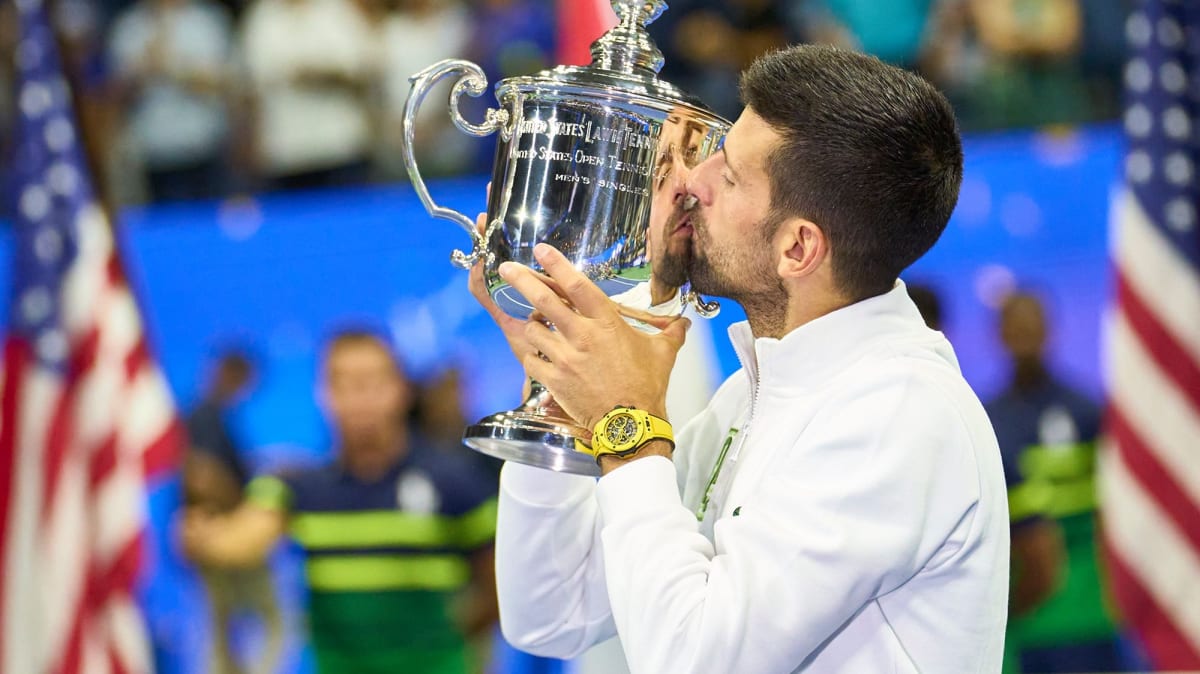Let us gather to celebrate, not to mourn. But here lies the men’s tennis GOAT debate. Oh, it was a hell of a run, and what fun it generated. This was a spirited discussion that crossed borders and eras, at once unifying and cleaving a sport’s fan base. It took a sinuous path, following the zigs and zags of on-court results. It asked us all to contemplate the essential—and extraneous—ingredients of sports greatness. But now it has come to its eternal resting place. May its memory be a blessing. Cue the organ music.
While there is no precise, official date of birth, records reveal that the GOAT debate took hold in late 2011. At that point, it was already clear that Roger Federer and Rafael Nadal were not simply generational talents but historically great talents. Then came a third party: a young Serb, Novak Djokovic, who turned the Federer-Nadal rivalry into a tri-valry. For the next decade-plus, the three stood atop the sport, kings but also gatekeepers who prevented all pretenders from entering their sacred space.
It was Federer who was the first to reach 20 majors, an unbreakable mark—or so we thought—that gave him the early lead in the GOAT derby. But then Nadal caught him. And then Djokovic did as well. At one point all three were tied in majors 20–20–20.
Fans weighed in—oh, did they weigh in.
Federer was the clear GOAT, with his grace and elegance and success at Wimbledon, the sport’s cathedral.
No, wait, Nadal was the GOAT on account of his persistence and, especially, his dominance at the French Open, where he won 14 titles in 18 years.
Hold on, the GOAT distinction belonged to Djokovic, whose tennis gifts may not have been obvious to the naked eye, but whose true superpower, mental fortitude, inoculated him from pressure and manifested in his winning head-to-head records against his two rivals: 27–23 against Federer, 30–29 against Nadal.
On it went. But just as even the most thrilling tennis rallies eventually end, the GOAT debate peacefully concluded in 2023—game, set, match. And for that, we can blame (which is to say, credit) Djokovic.

Sports Illustrated
First, some context: Federer retired in the fall of 2022 with an even 20 majors. Nadal, now 37, is currently on the precipice of retirement as well. He has not played in nearly a year due to injuries and may never play again, obviating any chance of adding to his haul of 22 majors. Djokovic, by contrast, turned 36—once thought to be doddering by tennis’s actuarial tables—but in ’23, he may well have turned in the finest year of his career, coming within a match (a game, really) of winning a Grand Slam.
His gilded campaign started in Australia, where a year before he’d been held in detention and then deported due to his COVID-19 vaccination status (or lack thereof). After batting aside that controversy (of his own making), he batted aside seven opponents and won the Australian Open for a record 10th time.
Though Nadal was absent from the field at the French Open, Djokovic confronted another Spanish nemesis, 20-year-old Carlos Alcaraz, an ascending star closer in age to Djokovic’s kids than to Djokovic himself. But Djokovic didn’t just beat Alcaraz; he dominated him physically. In a fierce semifinal match that lived up to its considerable advance billing, Djokovic delivered enough punishing rallies—“body blows,” he later called them—to leave the kid cramping and barely able to complete the match.
As Djokovic put it: “The positive thing about my game—and I’ve learned a lot about my game—is that as time goes on and the more matches you play, the more you learn about what do you need to do differently in order not to get into the black hole.”
The victory secured him his 23rd major, the all-time men’s record. A month later at Wimbledon, Djokovic won six matches to reach the final for the ninth time. There he met Alcaraz again, and this time youth beat experience. The kid exacted revenge, riding his strong serve to win a five-set instant classic 1–6, 7–6 (8–6), 6–1, 3–6, 6–4, thwarting Djokovic’s Grand Slam ambitions.
Though this defeat stung—“very, very, disappointing, I cannot lie,” he said—it energized Djokovic. A month later, in Cincinnati, it was his turn to beat Alcaraz in likely the best ATP Tour match of 2023. It doubled as an amuse-bouche for the U.S. Open. In New York, Alcaraz lost in the semis, but Djokovic did Djokovic things, marrying his offense with his defense, elevating his tennis when it mattered most to defeat Daniil Medvedev in the final in straight sets and take his 24th major.
It was as good a time as any to take stock of his excellence. The U.S. Open was the 72nd major of his career. He made a final for the 36th time and won for the 24th, tying him with Margaret Court for the most of all time. Put another way: He has made the final in half the majors he’s played and taken the title in one of every three. (Even the great Serena won “only” 23 of 81.) He has won each of the four Grand Slam events at least three times, and half of his major victories have come since he turned 30.
And, as he has rewritten tennis records, he has also reauthored his reputation. So often described as polarizing, he has won over many. Fans who once saw rough edges, compared to Federer and Nadal, now see a devoted father (during off days at the French Open, he took his kids hiking). They see a player whose pet cause is elevating prize money and working conditions for lower-ranked players. They see an unusually accessible celebrity. They see a competitor whose durability and flexibility and sheer ability place him among the greatest living athletes, sport be damned.
They see someone who didn’t just win the GOAT debate. He put it out to pasture.







